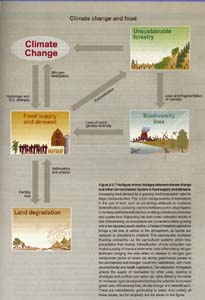Land Degradation and Desertification
and Climate Change
Projected levels of climate change would exacerbate
the continuation of land degradation and desertification that has occurred
over the past few centuries in many areas. Land-use conversion
and the intensive use of land, particularly in the world's arid and
semi-arid regions, has resulted in decreased soil fertility and increased
land degradation and desertification. The changes have been large enough
to be apparent from satellite images. Land degradation already affects
more than 900 million people in 100 countries, and one quarter of the
world soil resources, most of them in the developing countries. The annual
recorded losses of millions of hectares significantly undermine economies
and create some irreversible situations. The TAR projections using the
SRES scenarios indicate increased droughts, higher intensity of rainfall,
more irregular rainfall patterns, and more frequent tropical summer drought
in the mid-latitude continental interiors. The systems that likely would
be impacted include those with scarce water resources, rangelands, and
land subsidence (see Table 8-2).
![]() WGI TAR Sections 2.7.3.3,
9.3, & 10.3,
WGII TAR Section 5.5, &
WGII TAR Table SPM-1
WGI TAR Sections 2.7.3.3,
9.3, & 10.3,
WGII TAR Section 5.5, &
WGII TAR Table SPM-1
| Table 8-1: Examples for observed and projected regional implications of climate change on natural ecosystems, biodiversity, and food supply. | ||||||||
| Region | Impacts | Reference Section in WGII TAR | ||||||
| Africa | Irreversible losses of biodiversity could be accelerated with climate
change. Significant extinctions of plant and animal species are projected and would impact rural livelihoods, tourism, and genetic resources (medium confidence). |
TS 5.1.3 & Section 10.2.3.2 | ||||||
| Asia | Decreases in agricultural productivity and aquaculture due to thermal and water stress, sea-level rise, floods and droughts, and tropical cyclones would diminish food security in many countries of arid, tropical, and temperate Asia; agriculture would expand and increase in productivity in northern areas (medium confidence). Climate change would exacerbate threat to biodiversity due to land-use and land-cover change and population pressure (medium confidence). Sea-level rise would put ecological security at risk including mangroves and coral reefs (high confidence). | TS 5.2.1-2 & Sections 11.2.1 2 | ||||||
| Australia and New Zealand | A warming of 1ºC would threaten the survival of species currently
near the upper limit of their temperature range, notably in marginal
alpine regions. Some species with restricted climatic niches and that are unable to migrate due to fragmentation of the landscape soil differences or topography could become endangered or extinct (high confidence). Australian ecosystems that are particularly vulnerable to climate change include coral reefs, arid and semi-arid habitats in southwest and inland Australia, and Australian alpine systems. Freshwater wetlands in coastal zones in both Australia and New Zealand are vulnerable, and some New Zealand ecosystems are vulnerable to accelerated invasion by weeds. |
TS 5.3.2 & Sections 12.4.2, 12.4.4-5, & 12.4.7 | ||||||
| Europe | Natural ecosystems will change due to increasing temperature and atmospheric concentration of CO2. Diversity in nature reserves is under threat of rapid change. Loss of important habitats (wetlands, tundra, and isolated habitats) would threaten some species, including rare/endemic species and migratory birds. There will be some broadly positive effects on agriculture in northern Europe (medium confidence); productivity will decrease in southern and eastern Europe (medium confidence). | TS 5.4.2-3 & Sections 13.2.1.4, 13.2.2.1, 13.2.2.3-5, & 13.2.3.1 | ||||||
| Latin America | It is well-established that Latin America accounts for one of the
Earth's largest concentrations of biodiversity and the impacts
of climate change can be expected to increase the risk of biodiversity
loss (high confidence). Yields of important crops are projected
to decrease in many locations even when the effects of CO2
are taken into account; subsistence farming in some regions could
be threatened (high confidence). |
TS 5.5.2 & 5.5.4, & Sections 14.2.1-2 | ||||||
| North America |
There is strong evidence that climate change can lead to the loss
of specific ecosystem types (e.g., high alpine areas and specific
coastal (salt marshes and inland prairie "potholes") wetlands)
(high confidence). Some crops would benefit from modest warming
accompanied by increasing CO2, but effect would vary among
crops and regions (high confidence), including declines due
to drought in some areas of Canada's Prairies and the U.S. Great
Plains, potential increased food production in areas of Canada north
of current production areas, and increased warm temperate mixed forest
production (medium confidence). However, benefits for crops
would decline at an increasing rate and possibly become a net loss
with further warming (medium confidence). Unique natural
ecosystems such as prairie wetlands, alpine tundra, and coldwater
ecosystems will be at risk and effective adaptation is unlikely (medium
confidence). |
TS 5.6.4-5 & Sections 15.2.2-3 | ||||||
| Arctic | The Arctic is extremely vulnerable to climate change, and major physical, ecological, and economic impacts are expected to appear rapidly. | TS 5.7 & Sections 16.2.7-8 | ||||||
| Antarctic | In the Antarctic projected climate change will generate impacts that will be realized slowly (high confidence). Warmer temperatures and reduced ice extent are likely to produce long-term changes in the physical oceanography and ecology of the Southern Ocean, with intensified biological activity and increased growth rate of fish. | TS 5.7 & Sections 16.2.3 & 16.2.4.2 | ||||||
| Small Islands | Projected future climate change and sea-level rise will affect shifts
in species composition and competition. It is estimated that one out
of every three (30%) known threatened plants are island endemics,
while 23% of bird species are threatened. Coral reefs, mangroves,
and seagrass beds that often rely on stable environmental conditions
will be adversely affected by rising air and sea temperatures and
sea-level rise (medium confidence). Declines in coastal ecosystems
would negatively impact reef fish and threaten reef fisheries (medium
confidence). |
TS 5.8 & Sections 17.2.4-5 & 17.2.8.2 | ||||||
 |